A Three-Dimensional Analytical Framework: Textual Analysis and Comparison of Chinese and US Energy Blockchain Policies
Abstract
:1. Introduction
2. The Literature Review
2.1. Blockchain Technology
2.2. Energy Blockchain Technology
2.3. Policy Analysis Method
3. Method and Data
3.1. Data Sources and Collection
3.2. Analysis Framework
3.2.1. X Dimension: The Policy Tool of Energy Blockchain
3.2.2. Y Dimension: Innovation Value Chain of Energy Blockchain
3.2.3. Z Dimension: The Level of Energy Blockchain Policy
4. Results
4.1. General Situation Analysis
4.1.1. Trends in the Number of Policies
4.1.2. Textual Analysis of Energy Blockchain Policies
4.2. Application Analysis of Sino–US Energy Blockchain Policies Based on Three-Dimensional Structure
4.2.1. Three-Dimensional Analysis of China’s Energy Blockchain Policies
4.2.2. Three-Dimensional Analysis of US Energy Blockchain Policies
4.2.3. Further Analysis of Energy Blockchains in China and the US from the Perspective of Industry
4.3. Comparison of Energy Blockchain Policies in China and the US
4.3.1. Analysis of the Main Factors of Sino–US Energy Blockchain Policies
4.3.2. Comparison of Energy Blockchain Policies between China and the US
5. Conclusions and Policy Implications
5.1. Findings and Discussion
- (1)
- As can be seen in Figure 4, the trend of energy blockchain policy issuance in China and the United States has been increasing year by year. Obviously, from 2016 to 2019, the number of policies issued by both countries was small. This shows that the two countries have begun to explore the use of blockchain technology in the energy sector and introduced policies to encourage it. Since 2020, the number of energy blockchain policies in China has increased rapidly, while the US has shown a steady increase. As shown in this investigation, the two countries have confirmed the rationality of energy blockchains and have begun to promote them gradually.
- (2)
- From the perspective of the objectives and basic directions of the use of policy tools in China and the US, the word clouds (Figure 5) show that both the Chinese and US governments consider technology application the primary goal of energy blockchain development and regard technological innovation as the foundation of energy blockchain development. The difference is that China’s energy blockchain policies are more purposeful and pay more attention to policy output or policy effects. Development and application are the overall goals of China’s energy blockchain policies. The US government, similar to the Chinese government, emphasises the application of energy blockchain technology, discussing the integration of the blockchain and other digital technologies as policy support. The overall strategy of the US for energy blockchain technology support focuses on services and research, while China focuses on industrial landing. Overall, for the policy application of energy blockchain development, both countries have a clear functional distinction in their policy positioning. Presently, the countries highlight the use of environmental-based policy tools committed to building consensus and establishing a preliminary institutional framework to create a suitable social ecosystem for the development of the energy blockchain. At the same time, the countries highlight that scientific and technological support, among the supply-based policy tools, can help the development of the energy blockchain.
- (3)
- Comparison of energy blockchain policy profiles at the central and provincial levels in China.
- (4)
- Comparison of energy blockchain policy profiles at the federal and state levels in the US.
- (5)
- From an industry perspective (see Table 5), China’s energy blockchain policy gives the most support to the new-generation information technology industry, accounting for 51.61%, followed by the new energy industry and the energy conservation and environmental protection industry. It is also involved in the new energy automobile industry and related service industries. However, the energy blockchain policy of the US gives the most support to the new energy industry, followed by the new-generation information technology industry, and does not involve the new energy automobile industry. The policy distribution of each industry in different dimensions is basically consistent with that of the whole country.
- (6)
- Comparison of network relationships among policy-issuing agencies.
- (7)
- Comparison of energy blockchain policy structure and issues between China and the US.
5.2. Conclusions
- (1)
- Concerning policy tools, both China and the US tend to use environmental-based policy tools, followed by supply-based policy tools. Demand-based policy tools are the least frequently used. A change in the energy demand side can largely determine the future energy structure and the timing of the carbon peak. However, demand-based policy tools have single uses in both China and the US. Their internal structure is unbalanced, and many types of policy tools are underused;
- (2)
- Concerning the innovation value chain dimension, the energy blockchain policies of China and the US pay more attention to practical applications. The difference is that China has a pyramid structure and lacks policies in basic research, while the US lacks policy support in the exploitation stage. Research is the foundation of technology development and application. If a blockchain is hastily applied to the energy sector without sufficient knowledge and technical preparation, China can only superficially imitate and catch up with the achievements of developed countries; it will not be able to surpass them or lead the development in this field. According to China’s development status, the proportion of policy used for the energy blockchain, from high to low, should be research, exploitation, and application instead of the current inverted pyramid. As for the US, development is the combination and improvement of the existing key and core technologies to create new products or technologies. The small proportion of investment in development will affect the process and scope of commercialisation and industrialisation. The US should thus appropriately increase the proportion of its use of development policies;
- (3)
- Concerning the policy level, the distribution of energy blockchain policies in the US is relatively uniform, and the policies at all levels are relatively complete, which is conducive to ensuring the implementation of policies. However, as already mentioned, China has an inverted pyramid structure, with more policies at the strategic level and fewer policies at the implementation level. Presently, the basic purpose of China’s energy blockchain policies is to encourage the energy industry to use the blockchain for technological innovation and industrial optimisation. However, the implementation effect is not good, mainly because these policies are mostly concentrated at the strategic level, and there is a lack of guidance at the application level, which hampers policy implementation.
5.3. Policy Implications
5.4. Limitations and Further Research
Supplementary Materials
Author Contributions
Funding
Institutional Review Board Statement
Informed Consent Statement
Data Availability Statement
Conflicts of Interest
References
- Yan, J.; Yang, W.; Min, Z.; Yang, M. Innovation Strategy for Green Development and Carbon Neutralization in Guizhou—An Overview. Sustainability 2022, 14, 14377. [Google Scholar] [CrossRef]
- Jiang, N.; Liu, X.; Xu, M. Evaluating Blockchain Technology and Related Policies in China and the USA. Sci. Public Policy 2021, 48, 562–575. [Google Scholar] [CrossRef]
- Centobelli, P.; Cerchione, R.; Esposito, E.; Oropallo, E. Surfing Blockchain Wave, or Drowning? Shaping the Future of Distributed Ledgers and Decentralized Technologies. Technol. Forecast. Soc. Chang. 2021, 165, 120463. [Google Scholar] [CrossRef]
- McGahan, A.M.; Argyres, N.; Baum, J.A. Context, technology and strategy: Forging new perspectives on the industry life cycle. Bus. Strategy Ind. Lifecycle 2004, 21, 1–21. [Google Scholar] [CrossRef]
- Liu, F.-C.; Simon, D.F.; Sun, Y.-T.; Cao, C. China’s Innovation Policies: Evolution, Institutional Structure, and Trajectory. Res. Policy 2011, 40, 917–931. [Google Scholar] [CrossRef]
- Nakamoto, S. Bitcoin: A Peer-to-Peer Electronic Cash System. Decentralized Business Review, 31 October 2008; 21260. [Google Scholar]
- Kshetri, N. Blockchain’s Roles in Strengthening Cybersecurity and Protecting Privacy. Telecommun. Policy 2017, 41, 1027–1038. [Google Scholar] [CrossRef] [Green Version]
- Dai, J.; Vasarhelyi, M.A. Toward Blockchain-Based Accounting and Assurance. J. Inf. Syst. 2017, 31, 5–21. [Google Scholar] [CrossRef]
- Dimitropoulos, G. The Law of Blockchain. Wash. LAW Rev. 2020, 95, 1117–1129. [Google Scholar] [CrossRef]
- Pazaitis, A.; De Filippi, P.; Kostakis, V. Blockchain and Value Systems in the Sharing Economy: The Illustrative Case of Backfeed. Technol. Forecast. Soc. Chang. 2017, 125, 105–115. [Google Scholar] [CrossRef]
- Swan, M. Blockchain: Blueprint for a New Economy; O’Reilly Media, Inc.: Sebastopol, CA, USA, 2015. [Google Scholar]
- Wu, J.; Tran, N. Application of Blockchain Technology in Sustainable Energy Systems: An Overview. Sustainability 2018, 10, 3067. [Google Scholar] [CrossRef] [Green Version]
- Yeung, K. Regulation by Blockchain: The Emerging Battle for Supremacy between the Code of Law and Code as Law. Mod. Law Rev. 2019, 82, 207–239. [Google Scholar] [CrossRef]
- Wang, T.; Hua, H.; Wei, Z.; Cao, J. Challenges of Blockchain in New Generation Energy Systems and Future Outlooks. Int. J. Electr. Power Energy Syst. 2022, 135, 107499. [Google Scholar] [CrossRef]
- Baashar, Y.; Alkawsi, G.; Alkahtani, A.A.; Hashim, W.; Razali, R.A. Sieh Kiong Tiong Toward Blockchain Technology in the Energy Environment. Sustainability 2021, 13, 9008. [Google Scholar] [CrossRef]
- Wang, L.; Jiao, S.; Xie, Y.; Mubaarak, S.; Zhang, D.; Liu, J.; Jiang, S.; Zhang, Y.; Li, M. A Permissioned Blockchain-Based Energy Management System for Renewable Energy Microgrids. Sustainability 2021, 13, 1317. [Google Scholar] [CrossRef]
- Risius, M.; Spohrer, K. A Blockchain Research Framework: What We (Don’t) Know, Where We Go from Here, and How We Will Get There. Bus. Inf. Syst. Eng. 2017, 59, 385–409. [Google Scholar] [CrossRef]
- Kuo, C.-C.; Shyu, J.Z. A Cross-National Comparative Policy Analysis of the Blockchain Technology between the USA and China. Sustainability 2021, 13, 6893. [Google Scholar] [CrossRef]
- Novak, M. Crypto-Friendliness: Understanding Blockchain Public Policy. Public Policy 2020, 9, 165–184. [Google Scholar]
- Mainelli, M. Blockchain Will Help Us Prove Our Identities in a Digital World. Blockchain Insights You Need Harv. Bussiness Rev. 2017, 4. Available online: https://papers.ssrn.com/sol3/papers.cfm?abstract_id=3719801 (accessed on 17 July 2022).
- Tyan, I.; Yagüe, M.; Guevara-Plaza, A. Blockchain Technology for Smart Tourism Destinations. Sustainability 2020, 12, 9715. [Google Scholar] [CrossRef]
- Hughes, A.; Park, A.; Kietzmann, J.; Archer-Brown, C. Beyond Bitcoin: What Blockchain and Distributed Ledger Technologies Mean for Firms. Bus. Horiz. 2019, 62, 273–281. [Google Scholar] [CrossRef]
- Wang, Q.; Su, M. Integrating Blockchain Technology into the Energy Sector—From Theory of Blockchain to Research and Application of Energy Blockchain. Comput. Sci. Rev. 2020, 37, 25. [Google Scholar] [CrossRef]
- Dong, Z.; Luo, F.; Liang, G. Blockchain: A Secure, Decentralized, Trusted Cyber Infrastructure Solution for Future Energy Systems. J. Mod. Power Syst. Clean Energy 2018, 6, 958–967. [Google Scholar] [CrossRef] [Green Version]
- Khezami, N.; Gharbi, N.; Neji, B.; Braiek, N.B. Blockchain Technology Implementation in the Energy Sector: Comprehensive Literature Review and Mapping. Sustainability 2022, 14, 15826. [Google Scholar] [CrossRef]
- Davis, S.J.; Lewis, N.S.; Shaner, M.; Aggarwal, S.; Arent, D.; Azevedo, I.L.; Benson, S.M.; Bradley, T.; Brouwer, J.; Chiang, Y.-M.; et al. Net-Zero Emissions Energy Systems. Science 2018, 360, 1419–1429. [Google Scholar] [CrossRef] [PubMed] [Green Version]
- Obama, B. The Irreversible Momentum of Clean Energy. Science 2017, 355, 126–129. [Google Scholar] [CrossRef] [PubMed] [Green Version]
- Junne, T.; Xiao, M.; Xu, L.; Wang, Z.; Jochem, P.; Pregger, T. How to Assess the Quality and Transparency of Energy Scenarios: Results of a Case Study. Energy Strategy Rev. 2019, 26, 100380. [Google Scholar] [CrossRef]
- Poupeau, F.-M. Everything Must Change in Order to Stay as It Is. The Impossible Decentralization of the Electricity Sector in France. Renew. Sustain. Energy Rev. 2022, 120, 109597. [Google Scholar] [CrossRef]
- Zhu, S.; Song, M.; Lim, M.K.; Wang, J.; Zhao, J. The Development of Energy Blockchain and Its Implications for China’s Energy Sector. Resour. Policy 2020, 66, 101595. [Google Scholar] [CrossRef]
- Jin, M.; Feng, W.; Marnay, C.; Spanos, C. Microgrid to Enable Optimal Distributed Energy Retail and End-User Demand Response. Appl. Energy 2018, 210, 1321–1335. [Google Scholar] [CrossRef] [Green Version]
- Perera, A.T.D.; Nik, V.M.; Wickramasinghe, P.U.; Scartezzini, J.-L. Redefining Energy System Flexibility for Distributed Energy System Design. Appl. Energy 2019, 253, 113572. [Google Scholar] [CrossRef]
- Bridge, G.; Bouzarovski, S.; Bradshaw, M.; Eyre, N. Geographies of Energy Transition Space, Place and the Low-Carbon Economy. Energy Policy 2013, 53, 331–340. [Google Scholar] [CrossRef]
- Morstyn, T.; Hredzak, B.; Agelidis, V.G. Control Strategies for Microgrids With Distributed Energy Storage Systems: An Overview. IEEE Trans. Smart Grid 2018, 9, 3652–3666. [Google Scholar] [CrossRef] [Green Version]
- Andoni, M.; Robu, V.; Flynn, D.; Abram, S.; Geach, D.; Jenkins, D.; McCallum, P.; Peacock, A. Blockchain Technology in the Energy Sector: A Systematic Review of Challenges and Opportunities. Renew. Sustain. Energy Rev. 2019, 100, 143–174. [Google Scholar] [CrossRef]
- Cong, L.W.; He, Z. Blockchain Disruption and Smart Contracts. Rev. Financ. Stud. 2019, 32, 1754–1797. [Google Scholar] [CrossRef]
- Mihaylov, M.; Jurado, S.; Avellana, N.; Van Moffaert, K.; de Abril, I.M.; Nowe, A. NRGcoin: Virtual Currency for Trading of Renewable Energy in Smart Grids. In Proceedings of the 11th International Conference on the European Energy Market (EEM14); IEEE: Krakow, Poland, 2014; pp. 1–6. [Google Scholar]
- Chapron, G. The Environment Needs Cryptogovernance. Nature 2017, 545, 403–405. [Google Scholar] [CrossRef] [Green Version]
- Truby, J. Decarbonizing Bitcoin: Law and Policy Choices for Reducing the Energy Consumption of Blockchain Technologies and Digital Currencies. Energy Res. Soc. Sci. 2018, 44, 399–410. [Google Scholar] [CrossRef]
- Noor, S.; Yang, W.; Guo, M.; van Dam, K.H.; Wang, X. Energy Demand Side Management within Micro-Grid Networks Enhanced by Blockchain. Appl. Energy 2018, 228, 1385–1398. [Google Scholar] [CrossRef]
- Ahl, A.; Yarime, M.; Tanaka, K.; Sagawa, D. Review of Blockchain-Based Distributed Energy: Implications for Institutional Development. Renew. Sustain. Energy Rev. 2019, 107, 200–211. [Google Scholar] [CrossRef]
- Wang, S.; Taha, A.F.; Wang, J.; Kvaternik, K.; Hahn, A. Energy Crowdsourcing and Peer-to-Peer Energy Trading in Blockchain-Enabled Smart Grids. IEEE Trans. Syst. Man Cybern. Syst. 2019, 49, 1612–1623. [Google Scholar] [CrossRef] [Green Version]
- van Leeuwen, G.; AlSkaif, T.; Gibescu, M.; van Sark, W. An Integrated Blockchain-Based Energy Management Platform with Bilateral Trading for Microgrid Communities. Appl. Energy 2020, 263, 114613. [Google Scholar] [CrossRef]
- Pinheiro, C.A.R. Social Network Analysis in Telecommunication; John Wiley & Sons: Hoboken, NJ, USA, 2001. [Google Scholar]
- Carrington, P.J.; Scott, J.; Stanley, W. Models and Methods in Social Network Analysis; Cambridge University Press: New York, NY, USA, 2005; Volume 28. [Google Scholar]
- Provan, K.G.; Kenis, P. Modes of Network Governance: Structure, Management, and Effectiveness. J. Public Adm. Res. Theory 2007, 18, 229–252. [Google Scholar] [CrossRef] [Green Version]
- Rothwell, R.; Zegveld, W. An Assessment of Governmant Innovation Policies. In Government Innovation Policy; Palgrave Macmillan: London, UK, 1988; pp. 19–35. [Google Scholar]
- Morris, R. Computerized Content Analysis in Management Research: A Demonstration of Advantages & Limitations. J. Manag. 1994, 20, 903–931. [Google Scholar]
- Hansen, M.T.; Birkinshaw, J. The Innovation Value Chain. Harv. Bus. Rev. 2007, 85, 121. [Google Scholar]
- Bamfirld, P. Research and Development Management in the Chemical and Parmaceutical Industry; John Wiley & Sons: Hoboken, NJ, USA, 2003. [Google Scholar]
- Zhao, Y.; Peng, K.; Xv, B.; Liu, Y.; Xiong, W.; Han, Y. Applies Engineering Programs of Energy Blockchain in US. Energy Procedia 2019, 158, 2787–2793. [Google Scholar] [CrossRef]
- Huang, L.-Y.; Cai, J.-F.; Lee, T.-C.; Weng, M.-H. A Study on the Development Trends of the Energy System with Blockchain Technology Using Patent Analysis. Sustainability 2020, 12, 2005. [Google Scholar] [CrossRef] [Green Version]
- Zha, D.-S.; Feng, T.-T.; Gong, X.-L.; Liu, S.-Y. When Energy Meets Blockchain: A Systematic Exposition of Policies, Research Hotspots, Applications, and Prospects. Int. J. Energy Res. 2022, 46, 2330–2360. [Google Scholar] [CrossRef]
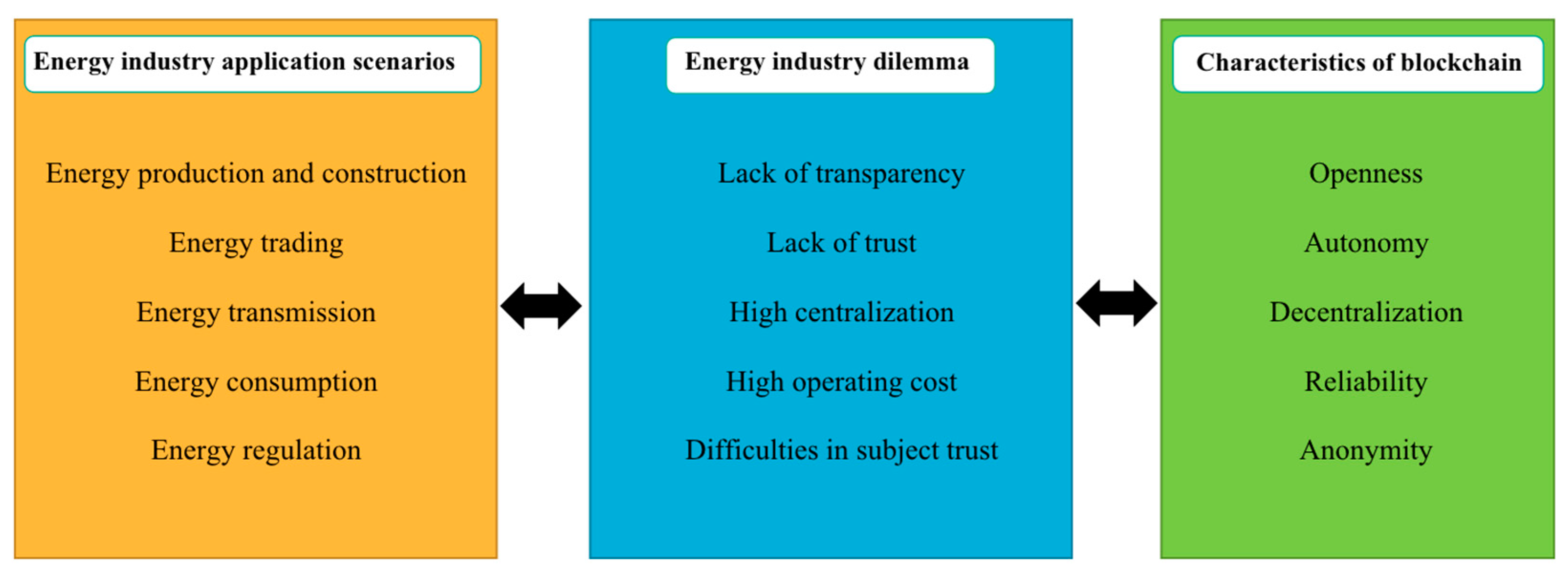
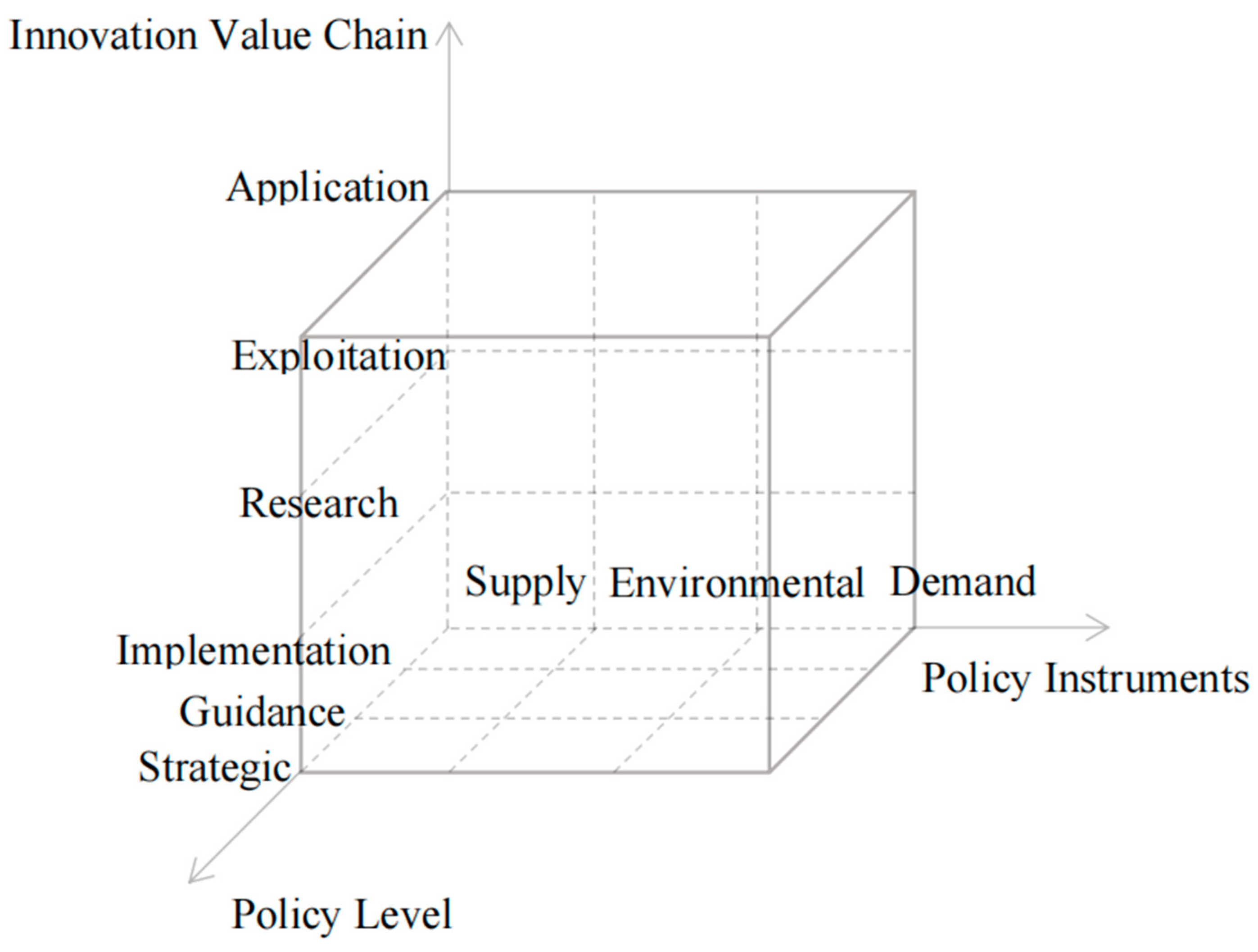
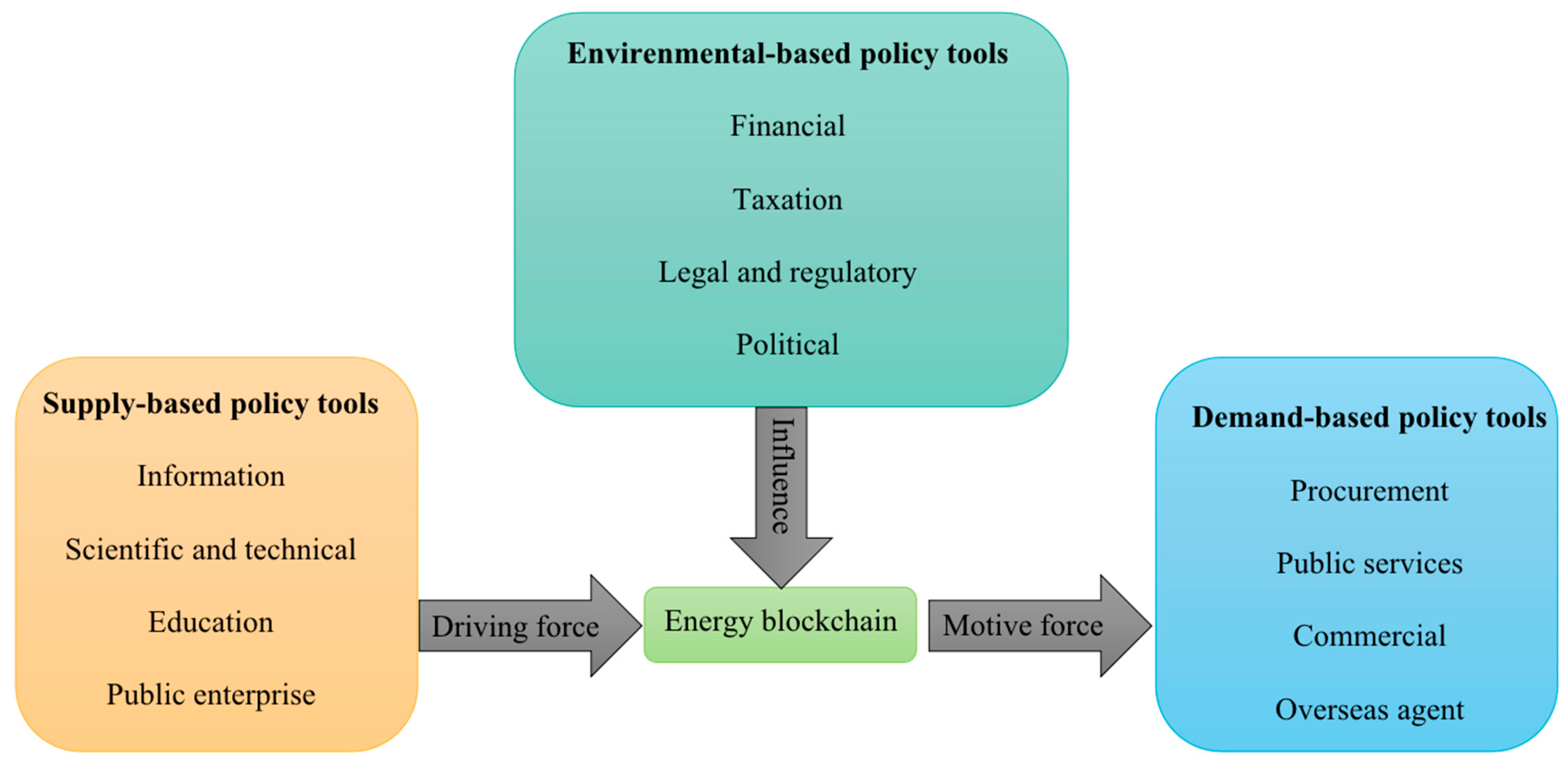
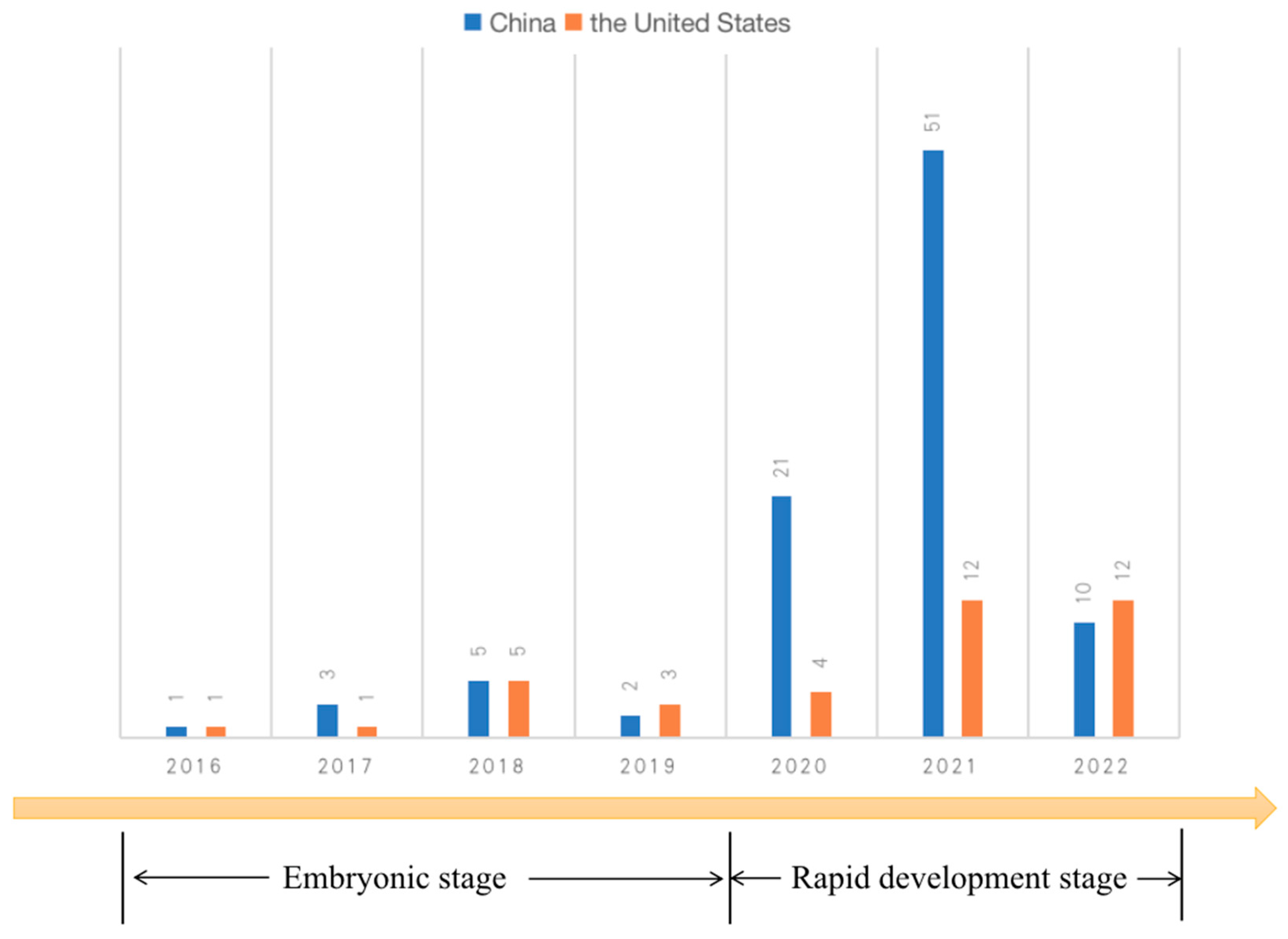
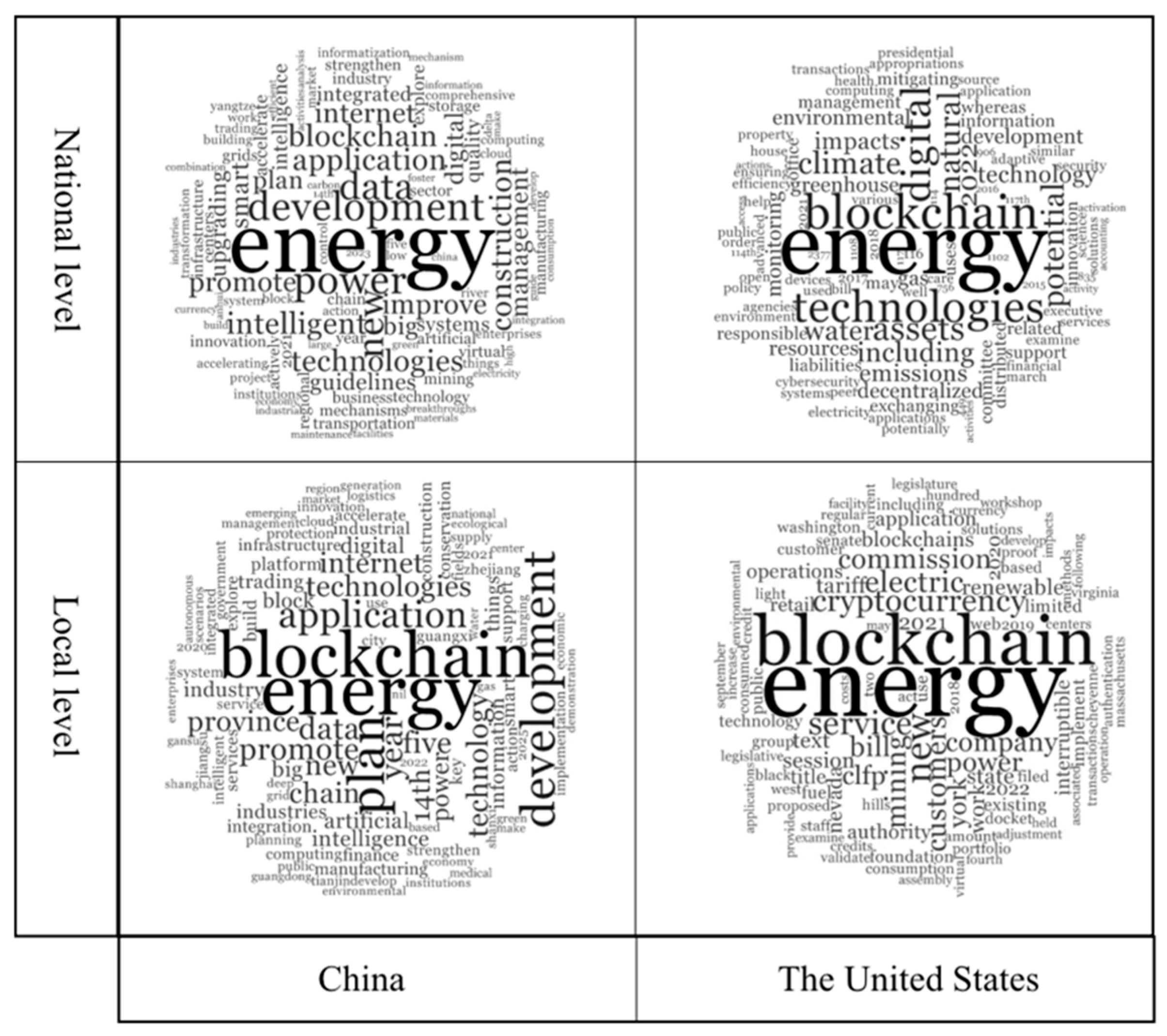
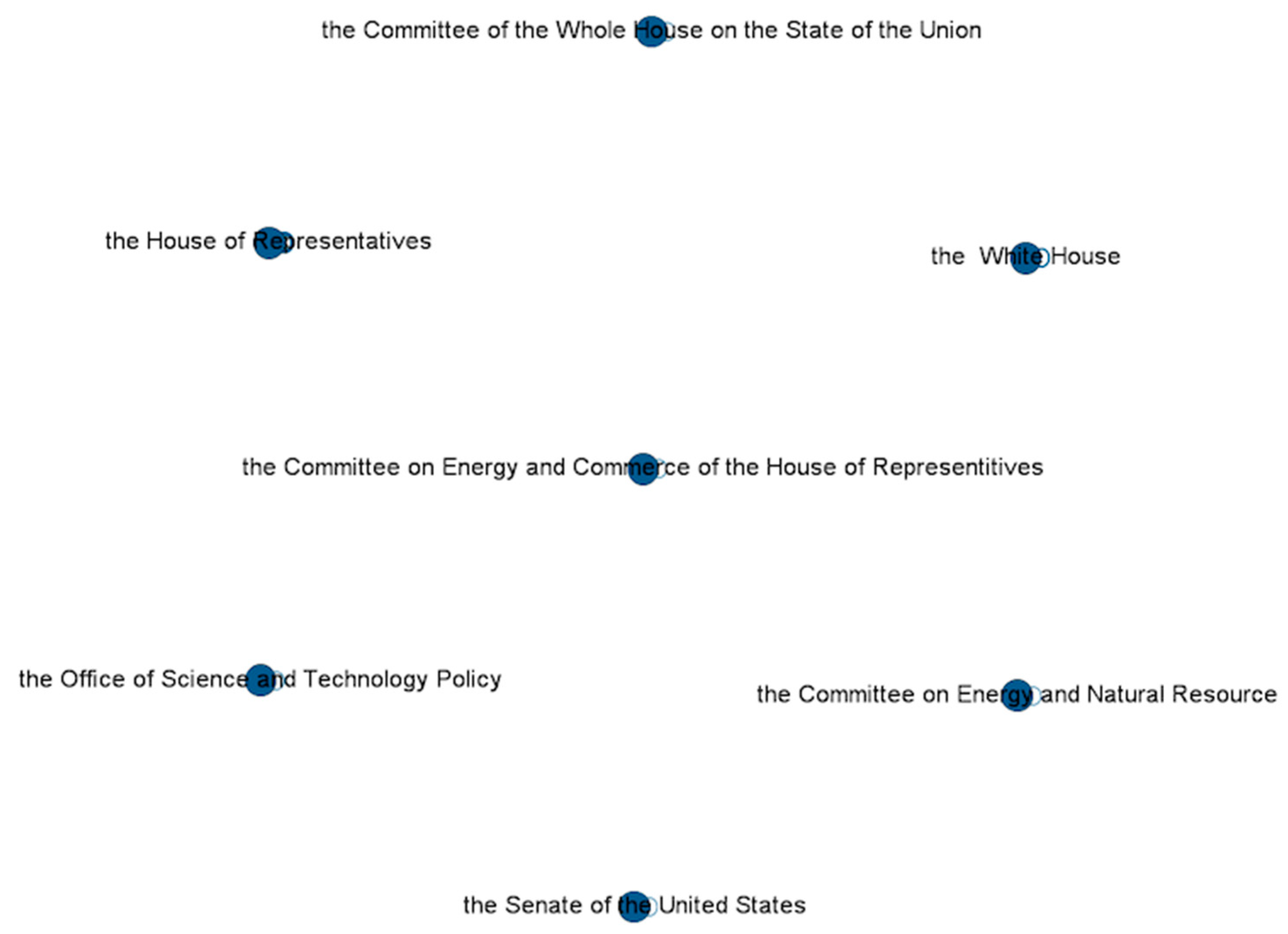


| Country | Application Scenario | Project | Project Features |
|---|---|---|---|
| The United States | Distributed energy trading | LO3 Energy’s Brooklyn Microgrid project | Smart meters provide users with real-time data on power generation, electricity consumption, and energy transactions through a blockchain. |
| The United States | Distributed energy trading | Wepower Platform | This platform allows renewable energy producers to issue their own energy tokens to raise funds, and WePower is connected to energy infrastructure and energy trading markets to bring energy trading and energy sales directly to market if there is not enough demand on the platform. |
| The United States | Distributed energy trading | US Department of Energy Laboratory and BlockCypher cooperation project | This project connects energy producers and consumers directly, enabling power producers, transmission network operators, distribution network operators, and energy suppliers to trade at multiple levels. |
| The United States | Electric vehicle charging and sharing | JuiceNet Internet of Things platform P2P charging | This project combines the two major needs of electric vehicle charging and sharing and uses distributed networks to realise convenient charging and trading. |
| China | Distributed energy trading | The Shekou Energy Blockchain project | Users can directly choose to use clean energy on the platform, and the platform will use blockchain technology to generate smart contracts, which will directly match the peer-to-peer virtual transactions between the power station and users, and issue authoritative e-certificates for users to prove that they are using clean energy electricity. |
| China | Optimisation of the energy commodity trading process | Shanghai Gas Energy Blockchain Project | This project realises the links of key data in the business processes of “tank storage”, “making pick-up orders”, and “gas station loading” of liquefied natural gas and supports the link data query. |
| China | Carbon emission permits and green trading | Energy Blockchain Lab carbon asset development project | By issuing digital assets based on certified carbon reduction, this platform includes participants in all aspects of carbon asset development in a blockchain-based shared, collaborative, and distributed trusted ledger to achieve blockchain-based document and data transfer. The project also involves electric vehicle account management, distributed photovoltaic electricity sale settlement, virtual power plant assessment plans, etc. |
| China | Renewable energy subsidies | State Grid Shanghai Electric Power distributed photovoltaic settlement project based on blockchain | This project introduces blockchain technology to the application, measurement, collection, and electricity fee calculation of photovoltaic settlement. |
| Types of Policy Instruments | Names | Implications for Energy Blockchain Policy Instruments |
|---|---|---|
| Supply-based | Information | Policies to encourage the marketisation of the energy blockchain include the establishment of information networks and centres, databases, consultation and liaison services, etc. |
| Scientific and technical | Government actions to promote the development of science and technology, such as establishing research laboratories and supporting research associations and professional associations. | |
| Education | Government policies for the education system, such as university general education, blockchain technology education, discipline development related to blockchains, and internships. | |
| Public enterprise | Measures related to the establishment and management of public enterprises, such as the innovation of public industries, the establishment of new industries, and the pioneering use of the energy blockchain by state-owned enterprises. | |
| Environmental-based | Financial | Financial assistance to enterprises, including loans, subsidies, financial sharing arrangements, equipment, premises, services, loan guarantees, and export credits. |
| Taxation | Tax incentives will be provided to companies and individuals engaged in energy blockchain research, production, investment, and consumption, such as tax reduction and exemption. | |
| Legal and regulatory | Measures to regulate the energy blockchain market, including patents, environmental and health regulations, inspectors, and monopoly regulations. | |
| Political | Short-term strategic measures to assist the development of the energy blockchain, such as planning regional policies, innovation honours or awards, encouraging mergers or consortia, and public consultation. | |
| Demand-based | Procurement | Central or local government procurement regulations related to energy blockchain projects or services, such as government procurement, public utilities procurement, and procurement contracts. |
| Public services | Supporting service measures for energy blockchain development, such as maintenance, supervision, and innovation in health services, construction, transportation, and telecommunications. | |
| Commercial | Restrictions on or incentives for import and export trade, including trade agreements, tariffs, and currency regulations. | |
| Overseas agent | The government establishes or assists enterprises in setting up various branches overseas, such as establishing overseas trade organisations. |
| Dimension | Tree Node | Child Node | Node Number at Central Level | Node Number at Local Level | Coverage at Central Level | Coverage at Local Level | Total (Central) | Total (Local) |
|---|---|---|---|---|---|---|---|---|
| Policy tool | Supply-based | Information | 1 | 3 | 5.26% | 4.05% | 31.58% | 31.08% |
| Scientific and technical | 4 | 17 | 21.05% | 22.97% | ||||
| Education | 1 | 0 | 5.26% | 0.00% | ||||
| Public enterprise | 0 | 3 | 0.00% | 4.05% | ||||
| Environmental-based | Financial | 0 | 0 | 0.00% | 0.00% | 57.89% | 52.70% | |
| Taxation | 0 | 0 | 0.00% | 0.00% | ||||
| Legal and regulatory | 0 | 0 | 0.00% | 0.00% | ||||
| Political | 11 | 39 | 57.89% | 52.70% | ||||
| Demand-based | Procurement | 0 | 0 | 0.00% | 0.00% | 10.53% | 14.86% | |
| Public service | 1 | 11 | 5.26% | 14.86% | ||||
| Commercial | 0 | 0 | 0.00% | 0.00% | ||||
| Overseas agent | 1 | 0 | 5.26% | 0.00% | ||||
| Innovation value chain | Research | 1 | 7 | 5.26% | 9.97% | 100.% | 100.% | |
| Exploitation | 6 | 9 | 31.58% | 11.54% | ||||
| Application | 12 | 62 | 63.16% | 79.49% | ||||
| Level | Strategic | 7 | 53 | 36.84% | 71.62% | 100% | 100% | |
| Guidance | 12 | 18 | 63.16% | 24.32% | ||||
| Implementation | 0 | 3 | 0.00% | 4.05% |
| Dimension | Tree Node | Child Node | Node Number at Federal Level | Node Number at State Level | Coverage at Federal Level | Coverage at State Level | Total (Federal) | Total (State) |
|---|---|---|---|---|---|---|---|---|
| Policy tool | Supply-based | Information | 0 | 0 | 0.00% | 0.00% | 28.57% | 37.50% |
| Scientific and technical | 4 | 9 | 28.57% | 37.50% | ||||
| Education | 0 | 0 | 0.00% | 0.00% | ||||
| Public enterprise | 0 | 0 | 0.00% | 0.00% | ||||
| Environmental-based | Financial | 0 | 2 | 0.00% | 8.33% | 64.29% | 62.50% | |
| Taxation | 1 | 3 | 7.14% | 12.50% | ||||
| Legal and regulatory | 6 | 6 | 42.86% | 25.00% | ||||
| Political | 2 | 4 | 14.29% | 16.67% | ||||
| Demand-based | Procurement | 0 | 0 | 0.00% | 0.00% | 7.14% | 0.00% | |
| Public service | 1 | 0 | 7.14% | 0.00% | ||||
| Commercial | 0 | 0 | 0.00% | 0.00% | ||||
| Overseas agent | 0 | 0 | 0.00% | 0.00% | ||||
| Innovation value chain | Research | 3 | 10 | 21.43% | 41.67% | 100% | 100% | |
| Exploitation | 2 | 1 | 14.29% | 4.17% | ||||
| Application | 9 | 13 | 64.29% | 54.17% | ||||
| Level | Strategic | 11 | 4 | 78.57% | 16.67% | 100% | 100% | |
| Guidance | 3 | 10 | 21.43% | 41.67% | ||||
| Implementation | 0 | 10 | 0.00% | 41.67% |
| China | The United States | ||||||
|---|---|---|---|---|---|---|---|
| Industry | Policy Tool (%) | Innovation Value Chain (%) | Policy Level (%) | Industry | Policy Tool (%) | Innovation Value Chain (%) | Policy Level (%) |
| New-generation information technology industry (51.61%) | S 25.00 | r 4.00 | s 77.08 | New-generation information technology industry (31.58%) | S 25.00 | r 41.67 | s 41.67 |
| E 56.25 | e 14.00 | g 18.75 | E 75.00 | e – | g 41.67 | ||
| D 18.75 | a 82.00 | i 4.17 | D – | a 58.33 | i 16.67 | ||
| New energy automobile industry (2.15%) | S 100.00 | r – | s 100.00 | New energy automobile industry (0.00%) | S – | r – | s – |
| E – | e – | g – | E – | e – | g – | ||
| D – | a 100.00 | i – | D – | a – | i – | ||
| New energy industry (27.96%) | S 61.54 | r 18.52 | s 61.54 | New energy industry (36.84%) | S 42.86 | r 21.43 | s 35.71 |
| E 26.92 | e 18.52 | g 38.46 | E 50.00 | e 21.43 | g 28.57 | ||
| D 11.54 | a 62.96 | i – | D 7.14 | a 57.14 | i 35.71 | ||
| Energy conservation and environmental protection industry (15.05%) | S 57.14 | r 6.67 | s 21.43 | Energy conservation and environmental protection industry (18.42%) | S 42.86 | r 71.43 | s 57.14 |
| E 35.71 | e 20.00 | g 71.43 | E 57.14 | e – | g 42.86 | ||
| D 7.14 | a 73.33 | i 7.14 | D – | a 28.57 | i – | ||
| Related service industry (3.23%) | S 33.33 | r – | s 66.67 | Related service industry (13.16%) | S 20.00 | r – | s 20.00 |
| E 66.67 | e – | g 33.33 | E 80.00 | e – | g 20.00 | ||
| D – | a 100.00 | i – | D – | a 100.00 | i 60.00 | ||
| China | USA | ||||
|---|---|---|---|---|---|
| Policy Instrument | Rank | Coverage | Policy Instrument | Rank | Coverage |
| Political | 1 | 53.76% | Scientific and technical | 1 | 34.21% |
| Scientific and technical | 2 | 22.58% | Legal and regulatory | 2 | 31.58% |
| Public service | 3 | 12.90% | Political | 3 | 15.79% |
| Information | 4 | 4.30% | Taxation | 4 | 10.53% |
| Public enterprise | 5 | 3.23% | Financial | 5 | 5.26% |
| Education | 6 | 1.08% | Public service | 6 | 2.63% |
| Overseas agent | 7 | 1.08% | |||
Disclaimer/Publisher’s Note: The statements, opinions and data contained in all publications are solely those of the individual author(s) and contributor(s) and not of MDPI and/or the editor(s). MDPI and/or the editor(s) disclaim responsibility for any injury to people or property resulting from any ideas, methods, instructions or products referred to in the content. |
© 2023 by the authors. Licensee MDPI, Basel, Switzerland. This article is an open access article distributed under the terms and conditions of the Creative Commons Attribution (CC BY) license (https://creativecommons.org/licenses/by/4.0/).
Share and Cite
Jiang, N.; Han, Q.; Zhu, G. A Three-Dimensional Analytical Framework: Textual Analysis and Comparison of Chinese and US Energy Blockchain Policies. Sustainability 2023, 15, 5192. https://doi.org/10.3390/su15065192
Jiang N, Han Q, Zhu G. A Three-Dimensional Analytical Framework: Textual Analysis and Comparison of Chinese and US Energy Blockchain Policies. Sustainability. 2023; 15(6):5192. https://doi.org/10.3390/su15065192
Chicago/Turabian StyleJiang, Nan, Qi Han, and Guohua Zhu. 2023. "A Three-Dimensional Analytical Framework: Textual Analysis and Comparison of Chinese and US Energy Blockchain Policies" Sustainability 15, no. 6: 5192. https://doi.org/10.3390/su15065192
APA StyleJiang, N., Han, Q., & Zhu, G. (2023). A Three-Dimensional Analytical Framework: Textual Analysis and Comparison of Chinese and US Energy Blockchain Policies. Sustainability, 15(6), 5192. https://doi.org/10.3390/su15065192






